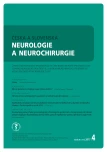-
Medical journals
- Career
Comment of Article The Effect of Different Occupational Therapy Techniques on Post-stroke Patients
Published in: Cesk Slov Neurol N 2017; 80/113(4): 469
Category: Comment
The article describes two methods of modern rehabilitation after stroke and compares the effects of occupational therapy using these two methods within the evidence-based medicine.
Constraint-induced movement therapy is recommended for paresis, which is retained partial mobility of affected extremities. Now it is proven to have a therapeutic effect after 30 min of treatment per day (compared with the previous 20 to 22 hours of therapy per day) [1].
Mirror therapy is a simple, excellent therapeutic method. It is a new rehabilitation strategy that has been proposed as a means therapy of stroke. Mirror therapy is also suitable for patients with total plegia limbs. It is a neuro-rehabilitation technique designed to remodulate cortical brain mechanisms. With this technique, patients perform movements using the unaffected limb whilst watching its mirror reflection superimposed over the (unseen) affected limb. This creates a visual illusion and provides positive feedback to the motor cortex that movement of the affected limb has occurred. The approach is thought to offer potential to improve function through the visual dominance upon motor and sensory processes [2].
Mirror therapy is recommended in both acute and chronic phases of rehabilitation after stroke [3]. Mirror therapy offers an easy-to-use, very effective and low-cost adjuvant therapeutic rehabilitation technique.
Petr Konečný, MD, Ph.D.
Department of Physiotherapy,
Faculty of Health Sciences Palacký University Olomouc
e-mail: Pet.Konecny@centrum.cz
Sources
1. Etoom M, Hawamdeh M, Hawamdeh Z, et al. Constraint-induced movement therapy as a rehabilitation intervention for upper extremity in stroke patients: systematic review and meta-analysis. Int J Rehabil Res 2016;39(3):197 – 210. doi: 10.1097/ MRR.0000000000000169.
2. Chang MY, Kim HH, Kim KM, et al. Effects of observation of hand movements reflected in a mirror on cortical activation in patients with stroke. J Phys Ther Sci 2017;29(1):38 – 42. doi: 10.1589/ jpts.29.38.
3. Perez-Cruzado D, Merchan-Baeza JA, Gonzalez-San-chez M, et al. Systematic review of mirror therapycompared with conventional rehabilitation in upperextremity function in stroke survivors. Aust OccupTher J 2017;64(2):91 – 112. doi: 10.1111/ 1440-1630.12342.
Labels
Paediatric neurology Neurosurgery Neurology
Article was published inCzech and Slovak Neurology and Neurosurgery

2017 Issue 4-
All articles in this issue
- Ataxia
- Patient with Hemiplegia Should be Transported Right to the Cerebrovascular Center
- Patient with Hemiplegia Should not be Transported Right to the Cerebrovascular Center
- Should be Patient with Hemiplegia Transported Right to the Cerebrovascular Center?
- Cognitive Functions in Low-grade Glioma Patients – a Systematic Review
- Clinical Importance of Radiological Parameters in Lumbar Spinal Stenosis
- Neurosonological Markers Predict ing Cognitive Deterioration
- Czech National Guillain-Barré Syndrome Registry
- The Role of Drug-induced Sleep Endoscopy in Treatment (Surgical and Non-surgical) in Patients with Obstructive Sleep Apnea
- Nerve Injuries in Supracondylar Humeral Fractures in Children
- A Comprehensive Nationwide Evaluation of Stroke Centres in the Czech Republic Performing Mechanical Thrombectomy in Acute Stroke in 2016
- Clinical View of the Otorhinolaryngologist and Radiologist on the Classification of Fractures of the Temporal Bone
- Experience with using the RevoLix Jr thulium laser – Case Reports
- Dissection of All Four Cervical Arteries in a Patient with Fibromuscular Dysplasia – a Case Report
- Intravenous Thrombolysis after Dabigatran Reversal with a Specific Antidote Idarucizumab
- The Czech Pneumological and Physiological Society and the Czech Society for Paediatric Pulmonology Guidelines for Long-term Home Treatment Using the CoughAssist Machine in Patients with Serious Cough Disorders
- Prevalence of Martin-Gruber Anastomosis – an Electrophysiological Study
- Mortality Prediction in a Neurosurgical Intensive Care Unit
- The Effect of Different Occupational Therapy Techniques on Post-stroke Patients
- Comment of Article The Effect of Different Occupational Therapy Techniques on Post-stroke Patients
- Czech and Slovak Neurology and Neurosurgery
- Journal archive
- Current issue
- Online only
- About the journal
Most read in this issue- Czech National Guillain-Barré Syndrome Registry
- Clinical View of the Otorhinolaryngologist and Radiologist on the Classification of Fractures of the Temporal Bone
- The Czech Pneumological and Physiological Society and the Czech Society for Paediatric Pulmonology Guidelines for Long-term Home Treatment Using the CoughAssist Machine in Patients with Serious Cough Disorders
- Nerve Injuries in Supracondylar Humeral Fractures in Children
Login#ADS_BOTTOM_SCRIPTS#Forgotten passwordEnter the email address that you registered with. We will send you instructions on how to set a new password.
- Career

